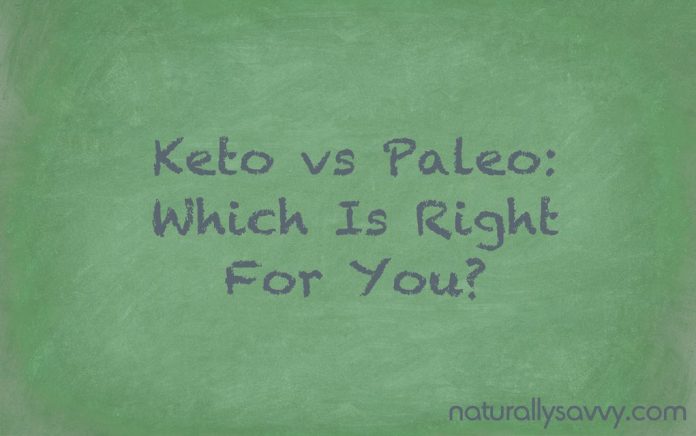
Being two of the most popular diets in the last few years, many people are looking at the keto vs paleo options, both of which promise weight loss and health benefits.
You think they’re the same thing, but they’re not. It’s the crucial specific differences that set them apart!
Do you want to improve your overall state of wellbeing?
Or are you desperate to shed fat at last?
Let’s ease your decision! We’ve compiled a list of the significant benefits and differences between these notorious low-carb diets to help you choose. First, however, let's do a quick review of each diet.
Dive in!

What is the keto diet?
The ketogenic (keto) diet is a very high-fat, low-carb way of eating that basically involves dramatically reducing your intake of foods that contain carbohydrates and replacing them with foods high in fat. When you take this approach, your body enters a metabolic state called ketosis.
Ketosis is a state in which the body can very effectively and efficiently burn fat for energy and consequently lose weight. During ketosis, fat is transformed into ketones in the liver, which can help fuel the brain. Keto diet foods also can have positive effects on various medical conditions, such as type 2 diabetes, Alzheimer’s, and it's a natural remedy for epilepsy. That’s how the keto diet was designed in the first place!
What is the paleo diet?
The paleo diet was designed to mimic what our hunter-gatherer ancestors consumed millennia ago. Some of our ancestors thrived on a low-carb diet that consisted of lots of animal foods (high in fat and protein), but others followed a high-carb diet that included lots of plants (moderate protein, low fat).
Generally, however, paleo diet foods include whole foods–meat, fish, eggs, fruits, vegetables, seeds, nuts, spices, herbs, healthy fats and oils. It does not include any processed or refined foods, sugar, soft drinks, legumes, most dairy foods, vegetable oils, artificial sweeteners, margarine, or trans fats.
Keto and paleo diets: the similarities
These low-carb diets have some distinct differences that separate their devotees. When listing the general characteristics of the two diets, however, you can quickly realize these two have a much more in common than you think!
1. Whole foods gospel
Forget about processed foods, junk food, and all frozen goodies that save your hunger in the middle of the night. It’s whole foods from now on, without any processed fats in the package! Prepare to cook with fresh vegetables, meat, nuts, and fish.
2. Legumes and grains are the enemies
Whether it’s because they contain carbs (says keto) or because they were not on the menu of the Paleolithic people, grains and legumes don’t have any place in either of these two diets.
3. Fats are good
There are two types of fats: the processed fats that are bad for you and both diets strictly forbid these. After all, consuming trans fats on a regular basis not only hurts your weight but your overall health as well.
On the other hand, healthy fats are a must in your shopping cart! Both diets are heavily based on these and encourage their intake! Some of the most common include:
- Avocado oil, extra virgin olive oil
- Red meat, fish, and fish oil
- Ghee, lard, cream, eggs, and other dairy products
- Coconut oil, cocoa butter, palm oil
- Nuts and seeds
These healthy fats can improve heart health, raise the levels of HDL, the good cholesterol, reduce blood pressure, and much more.
4. Hello, weight loss!
Last but not least, both diets help shed fat. There’s still a lack of long-term weight loss research that would show how effective these two diets are with time, but there are some optimistic short-term studies to prove the point!
According to this research with postmenopausal women, the paleo diet showed a decrease in fat loss throughout 6 and 12 months, but there was no additional change after 24 months.
This research on the keto diet showed that:
“The ketogenic diet acted as a natural therapy for weight reduction in obese patients. This is a unique study monitoring the effect of a ketogenic diet for 24 weeks. There was a significant decrease in the level of triglycerides, total cholesterol, LDL cholesterol and glucose, and a considerable increase in the level of HDL cholesterol in the patients.
The side effects of drugs commonly used for the reduction of body weight in such patients were not observed in patients who were on the ketogenic diet. Therefore, these results indicate that the administration of a ketogenic diet for a relatively long period is safe.”
Keto and paleo diets: the differences
1. Sweet differences
Forget about all types of sugar when you embark on the keto diet. Sugar is high in carbs, and you want to avoid it if you want to benefit as much as possible from the diet.
On the other hand, the Paleo allows sugar, but only unrefined: maple syrup and honey.
2. Lifestyle vs strict approach
The keto diet not primarily a lifestyle. Dramatic weight loss is the main goal of the ketogenic diet for most who try it, but this low-carb plan is strict. You have to give it all you have to reap the best results. Sometimes, you need an extra kick from the supplements as well. The Paleo diet also helps you lose weight, but the fat shedding process is not as extreme.
Keto diet has some available supplements (exogenous ketones, MCT oil, and others) that can get you into a state of ketosis faster, help you with weight loss and physical performance. You don’t have to take supplements of course; it’s just much easier especially at first. You can measure your ketone levels with a specific measuring device, blood ketone mete, as shown here.
If you’re convinced there’s something wrong with the modern food system, paleo is the diet for you. Also known as the Paleolithic or the caveman diet, this one has some ideology stored there for you.
The Paleo diet is a lifestyle. Yes, it forbids different foods, but it can contribute to your overall health, reduced stress levels, and weight loss as well. Paleo diet foods are more flexible, and you don’t need any special supplements to boost your new way of life. It improves digestive health, helps to balance blood sugar levels, and can have therapeutic benefits for autoimmune conditions.
3. Animal-based vs plant-based options
The keto diet menu is very heavy on animal-based foods, including meat, poultry, seafood, cheese, eggs, yogurt and cottage cheese, butter, and cream. Less emphasis is placed on plants, although some low-carb vegetables, berries, nuts and seeds, and avocados are acceptable. If you dig soy, then keto may work for you.
People who want to avoid animal-based foods or just include dairy can find a friend in paleo diet foods because fruits and vegetables are not limited. Alas, soy is not on the menu for paleo followers.
Going low-carb: which one to choose?
Keto vs paleo diet: That depends on you entirely.
Keto and paleo diets are essentially low-carb diets that can help you lose weight. They have more in common than you may think, but we've noted some of the specifics that set them apart.
Since it’s difficult to decide on something until you know what it is, you should review the similarities and differences between them, think about your needs and preferences, and then try them.
In short, the Paleo diet is a lifestyle.
Yes, it forbids different foods, but it can contribute to your overall health, reduced stress levels, and weight loss as well. The paleo menu is more flexible, and you don’t need any special supplements to boost your new way of life.
On the other hand, keto is the primary choice for those who want an impressively dramatic weight loss. That is the primary goal of the ketogenic diet for most who try it, but this low-carb plan is strict.
You have to give it all you have to reap the best results. Sometimes, you need an extra kick from the supplements as well.
Ask yourself these questions:
Do you have the will and energy to plan all your meals and strictly follow them no-questions-asked? Are you ready to stick to a rigid diet that demands a lot of your time and planning? Go for keto!
Do you want a complete lifestyle and better health with support for total wellness of your mind and body? Do you want to eat healthy but don't want to monitor the macronutrients and the food you consume regularly? Choose paleo.
The bottom line
The most apparent advantage of the two diets is weight loss. That’s usually the primary reason why people consider choosing one of these two. But there’s more to consider than just weight loss when selecting an eating program.
Paleo diet foods include those with carbs that are paleo approved. Keto will make you minimize your carb intake as much as possible. If you think you need at least some carbs in your life, paleo is the diet for you!
Test and monitor how you feel. If you don’t like one of these diets, try the other one. A keto vs paleo diet choice is one option. Overall, you should select a plan that suits your unique needs, lifestyle, and preferences–a diet you can live with.
Read This Next: Healthy Diet Plans To Try in 2019
Written by Bella Hardy from healthnerdy.com











